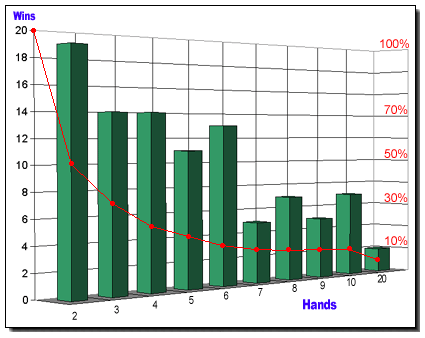 |

Two pips, American Airlines, Bullets, Snake Eyes, Sticks, Needles, Alan Alda, Albert Anastasia and pocket rockets. All these terms refer to one of the most popular hands to have in a game whose popularity has been gaining enormously over the past several years - Texas Hold'em. This variation of poker gives each player two cards to combine with a community pile of 5 cards to achieve the best five card hand. The strongest hand known in the game is an ace paired with another ace. In this experiment, Scientific AmeriKen will put the strength of this starting hand to the test and see just how well the ol' sticks hold up to scientific scrutiny!

Statistically AA will beat any single random hand 80-93% of the time; however, can AA hold up against more than one other hand at a time? Based off of extensive online "research" Scientific AmeriKen raises the hypothesis that AA is no where near as strong as one would expect. It is therefore hypothesis of this experiment that the strength of this starting hand will be diminished by the time there are 3 or more hands competing against AA.

Required for this experiment is one deck of cards, pen and paper. The experiment most follow all the rules of Texas Hold'em, Click here for rules. The first step is to hold two aces out of the deck and shuffle the deck 3 times. Deal out one other hand, then proceed in removing once card ("burning") from the top, deal out three cards ("flop"), burn one more, deal one more ("turn"), burn and deal a final card ("river"). Check to see if the dealt out hand has beaten the AA. Repeat this a total of 20 times. Then increase to 2 other hands, 3 other hands, ect. This experiment went through to AA vs 9 other hands and then did one extra step at AA vs 19 total hands.

The results are indicated below. Bars refer to number of victories for AA against the total number of hands. Red line refers to the winning percentage assuming all hands had an equal chance of winning.


The evidence from this experiment seems to refute the hypothesis as AA was still able to out compete up to 5 other hands winning at least 55% at that level. Although AA was able to out compete mere randomness at all levels, its effectiveness was severely diminished after competing against 6 or more hands. From a strategy viewpoint it becomes clear why one playing AA must initially raise to reduce the number of competitors before the flop.
In all, this research merely opens up many more questions, including: What is the predominant type of winning hand as hands increase? What is the percentage of winning hands when another ace falls? What does this chart look like for another hand like 7-2 offsuit?
Although interesting developments arose from this research, the answers to these questions and more trials to support the previous data are unlikely. Reasons include a lack of hurricanes that provided the countless hours of freedom without electricity used to churn this data out, as well as a recent government ban on online poker taking away any incentive to perform these experiments. However, Scientific AmeriKen remains hopeful that other scientist may take on these intriguing questions.
|
 |
|

